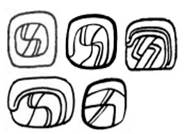![]()

![]()
![]()
![]()
K&H.p87 K&L.p40.#3 TOK.p14.r4.c2 BMM9.p12.r7.c1 JM.p247.#3 = JM.p247.#2 = K&L.p40.#3.2
TZ’AK TZ’AK TZ’AK TZ’AK TZ’AK:AJ
![]()
![]()
![]()
![]()
Stuart Stuart Stuart Stuart
CRN Panel 1 D7 CRN Panel 1 S6 CRN Panel 1 V2 CRN Panel 1 V5a
u.<TZ’AK:AJ> u.<TZ’AK:AJ> u.<TZ’AK:AJ> u:TZ’AK:AJ

Stuart
CPN Stela 10 F8
u.<10:<TZ’AK.ka>:<bu.li>> <K’INICH.<[K’IN]chi>.ni>:<YAX:<K’UK’[MO’]>>
· Mostly written with the logogram rather than spelled with syllabograms, though the latter also does occur.
· Utz’akaj – the “DNIG” – is the most frequent context where TZ’AK occurs.
· Tz’ahkbul can be written with or without li, but when without, it’s just an underspelling:
o MHD has an underspelled but inserted -h-.
o It has to do with succession, can be “nth in succession” (when u-bolon is not present).
o It has to do with “many counted” (of a dynasty) (when u-bolon is present).
· Tz’akbuj is written with ji (and of course without li):
o Note the absence of the inserted -h-.
o It is a noun, “succession”, and is often preceded by u- (“his succession”).
Concrete examples:
· u-TZ’AK-AJ è utz’ahkaj = “DNIG”
· u-TZ’AK-bu / u-TZ’AK-bu-li è utz’ahkbul = “his succession” [here u- is the possessive particle]
· u-<number>-TZ’AK-bu / u-<number>-TZ’AK-bu-li è u-<number> tz’ahkbul = “nth in succession” [here u- is the ordinal indicator]
· 9-TZ’AK-bu{l} è bolon-tz’ahkbul = “dynasty many-counted”
· 9-TZ’AK-bu{l} AJAW è bolon-tz’ahkbul ajaw = “dynasty many-counted lords”
· u-TZ’AK-bu-ji è utz’akbuj = “his succession”
Divide this into multiple entries for DNIG, successor, dynasty many-counted.
![]()
Martin
Randel Stela H4-I1-I2
18.<tz’a:ka> bu:li sa[ja]{l}
· A syllabogram-spelling, which is less common, but which does occur.